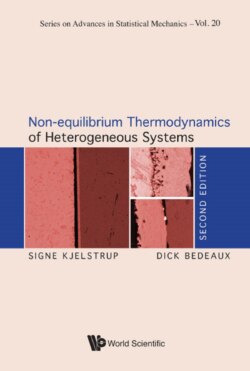Читать книгу Non-equilibrium Thermodynamics of Heterogeneous Systems - Signe Kjelstrup - Страница 14
2.3Experimental designs and controls
ОглавлениеThe importance of equilibrium thermodynamics for the design of experiments is well known. The definition, of say a partial molar property, explains what shall be varied, and what shall be kept constant in the experimental determination of the quantity. Also, there are relations between thermodynamic variables that offer alternative measurements. For instance, the enthalpy of evaporation can be measured in a calorimeter, but it can also be determined by finding the vapor pressure of the evaporating gas as a function of temperature.
Non-equilibrium thermodynamics is, in a similar way, instrumental for design of experiments that aim to find transport properties, cf. Chapter 20. To see this, consider the following exercise.
Exercise 2.3.1.Find the electric current in terms of the electric field E = −dϕ/dx using Eq. (2.7) in a system where there is no transport of heat and mass J′q = J = 0.
•Solution: It follows from Eqs. (2.7a) and (2.7b) that
Solving these equations, using the Onsager relations, one finds
Substitution into Eq. (2.7c) then gives
This exercise shows that the electric conductivity, that one measures as the ratio of measured values of j and E, is not necessarily given by Lϕϕ/T as one might have thought, considering Eq. (2.7c). In the stationary state, the coupling coefficients lead to temperature and chemical potential gradients, which again affect the electric current. Mathematically speaking, the electric conductivity then becomes a combination of the conductivity of a homogeneous conductor, which is found if one could measure with zero chemical potential and temperature gradients and additional terms. The combination of coefficients divided by the temperature is the stationary state conductivity. The stationary state electric conductivity, measured with J′q = J = 0, is experimentally distinguishable from the Ohmic electric conductivity of the homogeneous conductor, measured with dT/dx = dμT/dx = 0. Nonequilibrium thermodynamics helps define conditions that give well-defined experiments.
One important practical consequence of the Onsager relations is to offer alternative measurements for the same property. For instance, if it is difficult to measure the coefficient Lqϕ, one may rather measure Lϕq [80–83]. A valuable consistency check for measurements is provided if one measures both coupling coefficients in the relation. So, similar to the situation in equilibrium, the non-equilibrium systems also have possibilities for control of internal consistency.
